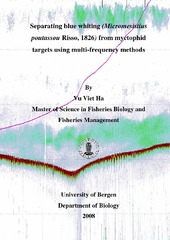| dc.description.abstract | Blue whiting (Micromesistius poutassou Risso, 1826) is a physoclists species, widely distributed in the Barents Sea, Norwegian Sea and Mediterranean Sea. They appear on the continental slope and shelf, in high concentration at 300-400 m depth. They play an important role in these ecosystems not only in term of abundance but also in the food chain. The abundance of the blue whiting stock is now estimated annually by acoustic methods. Traditionally, blue whiting was separated from other targets using catch information. Therefore, it often becomes problematic when only a few net samples are to be conducted. Multi-frequency method with an approach of measuring frequency response, r(f), is a reliable method for distinguishing between species recorded in echograms. Acoustic data collected during blue whiting surveys in 2005 and 2006 were used to calculate r(f) of blue whiting and myctophids. The r(f) of blue whiting and myctophids were estimated for each “trawl-polygon” and for schools recorded along the survey tracks. The results showed significantly differences in r(f) for blue whiting and myctophid groups. It is evidently believed that r(f) are reliable variables used to discriminate between these species. Two approaches were deployed to separate blue whiting and myctophids; the discriminant function analysis and the classification tree. The r(f) at 18, 38 and 70 kHz, the echo strength at 38 kHz, sA(38), and the depth of fish schools (school depth) were used as independent variables. Both discriminant function analysis and classification tree were successfully used to separate between species with a relatively high accuracy. r(18), r(70) and sA(38) were the most important variables in the discriminant function analysis while r(18) and r(38) were the most powerful variables in the classification tree method. During the survey in 2006, target strength, TS, of blue whiting was measured in situ using the TS probe method. The TS were estimated to be from -37 dB to -34 dB for 38 kHz and from -39 dB to -38 dB for 120 kHz. The relationship between target strength and length of fish was TS=20log(L)-64.2; L=26.0 cm. No significant relationship between TS and depth was found. The change in densities (tonnes/nmi2) of blue whiting in 2005 and 2006 were about +11.8%. Total biomass estimated for the 2005 survey was about 1.8 million tonnes within an area of 75,899 nmi2. In the 2006 survey, it was estimated around 1.0 million tonnes for an area of 38,131 nmi2. | en_US |
